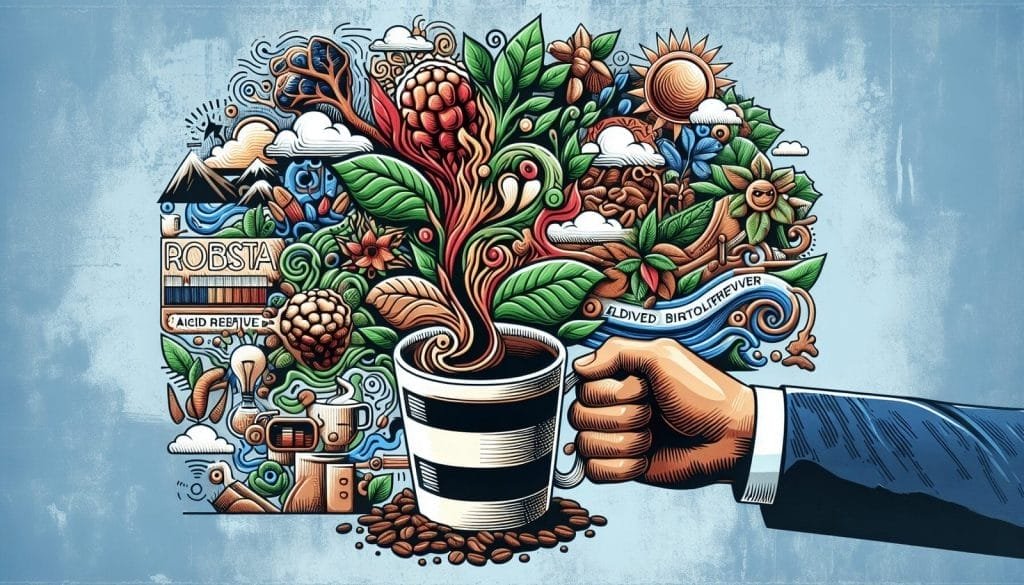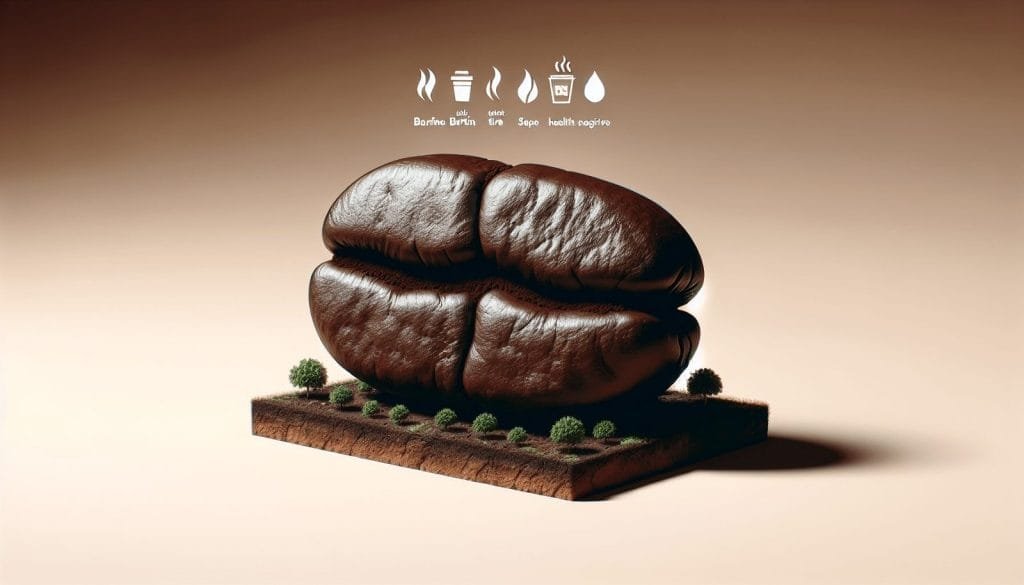You stand in front of the bustling coffee shop, contemplating your morning brew options. As you scan the menu, your eyes land on “Robusta Coffee.” Curiosity piqued, you wonder: What exactly are the disadvantages of robusta coffee? Though often overshadowed by its more popular counterpart, arabica coffee, robusta coffee has its own unique characteristics and drawbacks that are worth exploring. In this article, we will uncover the potential downsides of indulging in this strong and bold beverage, shedding light on the lesser-known pitfalls of robusta coffee.

Lower Quality Taste
Bitter and less flavor
When it comes to taste, robusta coffee falls short compared to its counterpart, arabica. The distinct bitterness of robusta coffee can be overwhelming for some, and its flavor is often described as dull and lacking in complexity. While arabica beans offer a wide range of flavors, including fruity, nutty, and chocolatey notes, robusta coffee cannot boast the same level of richness and depth. Its lower quality taste makes it less appealing to coffee connoisseurs who value the complex flavor profiles found in specialty coffees.
Lack of complexity
One of the reasons why robusta coffee is often considered of lower quality is because it lacks the complexity found in arabica beans. While arabica beans have a nuanced flavor profile with multiple layers of taste, robusta coffee tends to be one-dimensional. Its flavor is dominated by a strong, earthy taste, which can be overpowering and leave little room for subtlety. The lack of complexity in robusta coffee makes it less enjoyable for those seeking a truly exceptional coffee experience.
Harsh aftertaste
Another disadvantage of robusta coffee is the harsh aftertaste it often leaves lingering on the palate. The bitterness of robusta can be overwhelming, and the aftertaste can be described as harsh and unpleasant. This can detract from the overall drinking experience and make it less enjoyable compared to arabica coffee, which typically has a more balanced and pleasant aftertaste. For those who appreciate a smooth finish to their coffee, robusta may not meet their expectations.
Higher Caffeine Content
Can cause jitters and restlessness
If you’re someone who is sensitive to caffeine or easily experiences its effects, robusta coffee may not be the best choice for you. Robusta beans contain a higher caffeine content compared to arabica beans, which means that consuming robusta coffee can potentially lead to jitters, restlessness, and increased anxiety. This can be particularly problematic for individuals who are prone to caffeine-induced side effects or have pre-existing conditions that can be exacerbated by high caffeine consumption.
May lead to insomnia
Another disadvantage of the higher caffeine content in robusta coffee is its potential to cause sleep disturbances. Consuming robusta coffee too close to bedtime or in excessive amounts can make it difficult for individuals to fall asleep or have a restful night’s sleep. Insomnia can have a negative impact on overall health and well-being, and if you struggle with sleep, it might be worth considering opting for arabica coffee, which typically has a lower caffeine content.
Potential for caffeine addiction
Because of its higher caffeine content, robusta coffee has a higher potential for caffeine addiction compared to arabica coffee. Caffeine addiction can occur when an individual becomes dependent on caffeine to function, and the withdrawal symptoms experienced when caffeine is not consumed can be unpleasant. While moderate caffeine consumption is generally considered safe for most individuals, it’s important to be aware of the potential addictive qualities of robusta coffee and its impact on personal caffeine intake.
Inferior Aroma
Less pleasant aroma profile
One of the distinct disadvantages of robusta coffee is its inferior aroma profile compared to arabica. The aroma of robusta coffee is often described as less pleasant and less captivating. While arabica beans offer a wide range of enticing aromas, including floral, fruity, and caramel notes, robusta coffee tends to have a more earthy and sometimes pungent scent. The less appealing aroma of robusta coffee can impact the overall sensory experience and make it less enjoyable for those who value the aroma as an integral part of their coffee experience.
Lacks the nuanced fragrance of arabica
The nuanced fragrance found in arabica coffee is often missing in robusta beans. Arabica beans possess a delicate and complex aroma profile, which is highly sought after by coffee enthusiasts. On the other hand, robusta coffee lacks the same level of fragrance, and its aroma is often less refined and captivating. The absence of the nuanced fragrance in robusta coffee can be disappointing for those who appreciate the intricate scents that can be found in specialty arabica coffees.
Less Desirable Appearance
Uneven size and shape of beans
When it comes to physical appearance, robusta coffee beans often fall short compared to arabica. Robusta beans can be uneven in size and shape, which can present challenges during processing. The irregularity in size and shape can affect the consistency of the grind, potentially leading to inconsistencies in flavor extraction. Additionally, the uneven appearance of robusta beans may not be visually appealing to those who appreciate the aesthetics of coffee beans.
Dull and less visually appealing
In addition to the uneven size and shape, robusta coffee beans have a dull and less visually appealing appearance compared to arabica beans. Arabica beans are known for their vibrant colors and distinct patterns, which can be visually striking. Robusta beans, on the other hand, often have a more uniform and less visually interesting appearance. The lackluster visual appeal of robusta coffee can be a disadvantage for coffee enthusiasts who appreciate the beauty and artistry of coffee beans.

Higher Acidity Levels
Can cause stomach discomfort and acid reflux
If you have a sensitive stomach or are prone to digestive issues, robusta coffee’s higher acidity levels may pose a disadvantage for you. Robusta coffee tends to have higher acidity compared to arabica coffee, which can lead to stomach discomfort, acid reflux, and heartburn. The increased acidity in robusta coffee can be harsh on the digestive system and may cause discomfort for individuals with pre-existing gastrointestinal conditions.
May lead to enamel erosion and tooth decay
Another concern regarding the higher acidity levels in robusta coffee is its potential impact on oral health. The acidity in robusta coffee can contribute to enamel erosion, leading to weakened teeth and increased risk of tooth decay. It’s important to be mindful of oral hygiene practices and consider the potential effects of robusta coffee on dental health, especially for those who consume it regularly.
Pest Susceptibility
More prone to pests and diseases
Robusta coffee plants are more susceptible to pests and diseases compared to arabica coffee plants. Robusta plants tend to be less resistant to various pests and diseases, which can negatively impact crop yield and quality. This increased vulnerability to pests and diseases may necessitate the use of intensive pesticide treatments, which can have environmental and health implications. The pest susceptibility of robusta coffee can pose challenges for farmers and impact the sustainability of its cultivation.
Requires intensive pesticide use
To combat the pests and diseases that robusta coffee plants are more prone to, farmers often resort to intensive pesticide use. This reliance on pesticides may have adverse effects on the environment and contribute to the contamination of soil, water, and surrounding ecosystems. The excessive use of pesticides can also pose health risks for farmers and consumers alike. The need for intensive pesticide use in robusta coffee cultivation highlights a significant disadvantage from both an environmental and health perspective.
Environmental Impact
High water consumption during cultivation
Robusta coffee cultivation requires significant amounts of water, which can have negative environmental implications, particularly in regions with water scarcity. The high water consumption of robusta coffee can contribute to increased pressure on local water resources and exacerbate water scarcity issues. In an era where sustainable practices are becoming increasingly important, the environmental impact of robusta coffee’s water requirements must be taken into consideration.
Deforestation for robusta plantations
Another disadvantage of robusta coffee is its potential contribution to deforestation. As the demand for robusta coffee increases, there is a risk of expanding plantation areas by clearing forests. This deforestation can have severe consequences for biodiversity, carbon sequestration, and local ecosystems. It is crucial to prioritize sustainable agricultural practices and mitigate the negative impacts of robusta coffee cultivation on deforestation.
Limited Geographical Suitability
Grows well in specific climates and altitudes
Unlike arabica coffee, which can be grown in a wider range of climates and altitudes, robusta coffee is more limited in its geographical suitability. Robusta plants thrive in tropical climates and lower altitudes, making them less adaptable to different environments. This limited geographical suitability poses challenges for farmers in regions where robusta coffee cannot be grown, as it restricts potential cultivation locations and opportunities for economic development.
Restricts potential cultivation locations
The specialized climatic and altitude requirements of robusta coffee restrict its potential cultivation locations. This limitation can have economic implications for regions that are unable to cultivate robusta coffee due to unsuitable conditions. The restriction on potential cultivation locations also contributes to the limited availability of robusta coffee compared to arabica, further impacting its market demand and commercial viability.
Lower Market Demand
Less desirable among specialty coffee consumers
Robusta coffee faces lower market demand compared to arabica coffee, particularly among specialty coffee consumers. The discerning tastes of specialty coffee consumers often prioritize the complex flavor profiles and nuanced characteristics found in arabica beans. The perception of robusta coffee as lower quality and its less desirable taste and aroma contribute to its lower market demand among coffee enthusiasts who seek exceptional and distinctive coffees.
Lower price compared to arabica
The lower market demand for robusta coffee is reflected in its pricing compared to arabica coffee. Robusta coffee tends to be priced lower due to its perceived lower quality and reduced market demand. This lower price can be advantageous for those seeking a more affordable coffee option but can also impact the economic viability of coffee farmers who rely on robusta coffee cultivation. The lower market demand for robusta coffee leaves it at a disadvantage in terms of financial sustainability.
Processing Challenges
Difficulties in achieving consistency during processing
Processing robusta coffee can present challenges due to its uneven size and shape. The variability in bean size and shape can make it difficult to achieve consistency during processing, affecting the extraction of flavors and resulting in inconsistencies in the final product. This can be problematic for both farmers and roasters who strive for consistency in their coffee offerings. Overcoming the processing challenges associated with robusta coffee requires specialized techniques and careful attention to detail.
Requires specialized techniques for best results
To optimize the flavor and quality of robusta coffee, specialized processing techniques are often necessary. These techniques may include specific roasting methods, precise brewing parameters, and meticulous quality control measures. Achieving the best results with robusta coffee requires a deep understanding of its unique characteristics and the implementation of specialized techniques throughout the entire coffee production process. The need for specialized techniques poses a disadvantage for those who may not have access to knowledge or resources in order to maximize the potential of robusta coffee.
In conclusion, robusta coffee presents several disadvantages compared to its counterpart, arabica. From its lower quality taste, higher caffeine content, and inferior aroma to its less desirable appearance and higher acidity levels, robusta coffee falls short in terms of overall taste and sensory experience. Additionally, the pest susceptibility, environmental impact, limited geographical suitability, lower market demand, and processing challenges associated with robusta coffee present significant obstacles for both producers and consumers. While robusta coffee may still have its merits in certain contexts, it is crucial to acknowledge and understand its disadvantages to make well-informed choices in the world of coffee.




